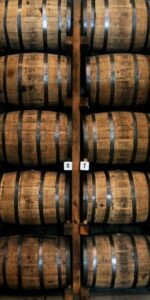 The barrel aging process is a critical and fascinating stage in the production of whiskey and bourbon, where the spirit undergoes transformative changes while maturing inside wooden barrels. This aging process is essential in shaping the flavor, aroma, and character of these beloved spirits. Let's delve into the intricacies of barrel aging and understand what it does.
The barrel aging process is a critical and fascinating stage in the production of whiskey and bourbon, where the spirit undergoes transformative changes while maturing inside wooden barrels. This aging process is essential in shaping the flavor, aroma, and character of these beloved spirits. Let's delve into the intricacies of barrel aging and understand what it does.

Wood Selection: The choice of wood for barrels is vital. Oak, especially American white oak, is the most commonly used wood due to its unique properties. Oak barrels are prized for their ability to impart desirable flavors and aromas to the whiskey. The wood's porous nature allows for the spirit to interact with the wood, and it also filters out undesirable compounds.
Flavor Extraction: As whiskey or bourbon sits in the barrel, it undergoes a process of flavor extraction. The wood imparts a wide range of flavors, including vanilla, caramel, toffee, and spices. These flavors come from compounds within the wood, such as lignin, tannins, and vanillin, which are gradually released into the spirit.
Color Development: The aging process also contributes to the rich color of whiskey and bourbon. Initially, the liquid is clear, but as it interacts with the charred inner surface of the barrel, it absorbs pigments and develops a deep amber or caramel hue.
Chemical Reactions: Inside the barrel, various chemical reactions take place. Esterification, oxidation, and polymerization are just a few examples. These reactions alter the chemical composition of the spirit, leading to the formation of complex and desirable compounds that enhance the overall flavor profile.
Mellowing and Smoothing: Over time, the harsh and sharp edges of the new distillate are mellowed and smoothed out. This results in a more balanced and refined taste, with less of the fiery or astringent notes that may be present in the fresh distillate.
Temperature Fluctuations: Temperature fluctuations, especially in regions with distinct seasons, play a significant role in the aging process. The spirit expands and contracts within the barrel as temperatures rise and fall, which facilitates the movement of the liquid in and out of the wood, further enhancing flavor extraction.
Angel's Share: During aging, some of the liquid is lost to evaporation, often humorously referred to as the “angel's share.” This loss can be as much as 2-3% of the barrel's contents each year. While it reduces the overall quantity, it concentrates the flavors of what remains.
Aging Duration: The duration of aging varies depending on the type of whiskey or bourbon being produced and the desired flavor profile. Some whiskeys may age for several years, while others, like bourbon, typically require a shorter aging period due to the climate and the new charred oak barrels used.
Terroir Influence: Just as wine grapes reflect the terroir of their growing region, whiskey and bourbon can also be influenced by the environment. The geographical location of aging warehouses, with variations in temperature and humidity, can impart distinct regional characteristics to the final product.
As you can see, the barrel aging process is a transformative journey for whiskey and bourbon, imbuing them with a complex array of flavors, colors, and textures that make each batch unique. This artful process, often described as a dance between the spirit and the wood, is a testament to the craftsmanship and patience required to create these beloved spirits. Whiskey and bourbon enthusiasts appreciate the magic that occurs within those barrels, resulting in the diverse and cherished range of flavors that make these spirits so beloved worldwide.
